Autumn in the Rain, Mount Rainier NP
No Comments
Part 3 of 4: 1 | 2 | 3 | 4
Last October, I visited Mount Rainier National Park during two days of continuous rain. In this post, you will find out about the subjects I was able to photograph in those conditions, including some of the best fall foliage and waterfalls in the park.
After getting out of the ferry from Stehekin at sunset time, I drove immediatly towards the east entrance of Mount Rainier National Park. Since the sky was still clear in Lake Chelan, I was hoping for some night photography at Tipsoo Lake. However, as I drove up towards Chinook Pass, it began to rain so heavily that I was barely able to see the road. This would set the tone for the next days of steady rain. Unlike at some other parks, the campgrounds in Mount Rainier all close in late September. The day before I flew to Seattle, the long-term weather forecast looked iffy, so instead of a sedan, I had rented a mini-van. In my experience, many US rental mini-vans are US-made cars in which all seats can be collapsed into the floor, offering much more living space than a SUV of equivalent size. I found a pullout that would put me at a sufficient distance from the roadway, and crawled to the back of the car, where there was plenty of space for sleeping, without even having to shuffle gear around.
In the morning, the visibility was almost zero. If this would have been my first visit to the park, I would have been disappointed not to see the Mount Rainier, but since it was my 7th visit, I was content with looking for more intimate scenes. Faced with rainy weather, you can stay in your room, or you can make the best of the conditions and find plenty of photographs not possible on a sunny day. Rainy weather provides excellent light for forest and waterfall scenes. I had come to the park in autumn only once, and this was in September. Being mid-October, I was hoping to find more autumn color at lower elevations in the south-east corner of the park. As this side of the park receives less rainfall than the western side, I thought it may be a good choice in rainy weather.
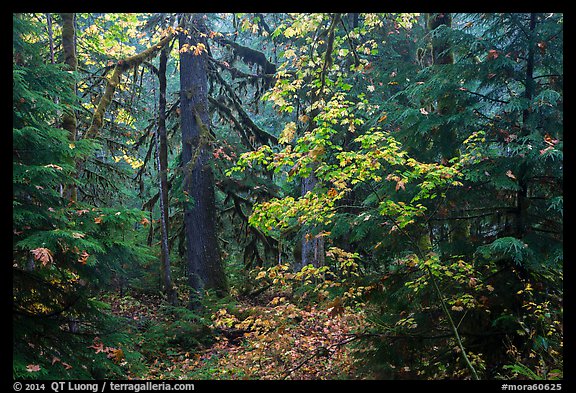
I had read that the East Side Trail had great waterfalls and cascades. However, I wasn’t keen on hiking its entire one-way 9 miles in the rain, especially since very light traffic would make hitch hiking a ride back difficult. Instead, I checked both ends of the trail, where waterfalls are accessed through short hikes. You want to be able to dry out a bit in the car! At the north end, I parked at the Owyhigh Lakes trailhead, situated on the west side of Hwy 123, half of mile south of the bridge over Deer Creek. After hiking down about a quarter of mile, I found an impressive viewpoint over multi-tiered Deer Creek Falls, next to the trail, above a sheer drop. I continued down the trail to the bridge over the creek, but did not find views.
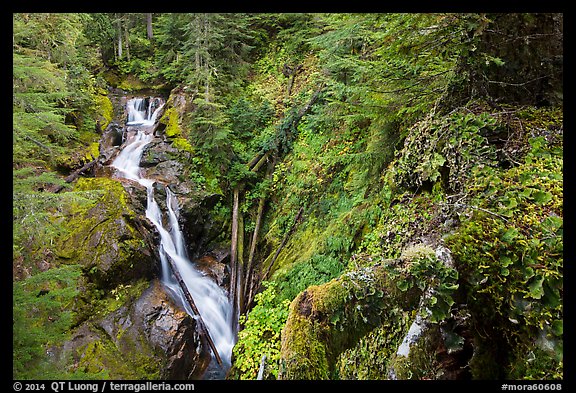
At the south end of East Side Trail, I hiked to Silver Falls. There are several ways to get to this waterfall, but the shortest (0.6 miles RT) is down from a trailhead on Hwy 123 south of Stevens Canyon Entrance.

In between those two short hikes, I parked at a pullout next to the bridge over Panther Creek, and hiked down to the creek. Wearing shorts and river shoes (an odd combination with top rain jacket and fleece!), I walked into the riverbed for a less common perspective. Despite the creek not being glacier-fed, I found the water freezing, even with neoprene socks, so I did not wade to the cascades that I had spotted in the distance.

In mid-October, plenty of vine maple added bright touches of yellows and oranges to the dark forests of the area.

Mushrooms seemed to be growing everywhere. Those ground views (part of this series) were the most easy photographs to make in the rain. Since the camera was pointing down, I didn’t have to worry about the front element of the lens getting water drops. I’ll write a bit more about photographing in the rain in the next post.

After a restful night at another pullout (no night photography because of the rain), I started the next day by walking down the closed road to the Ohanapecosh campground in order to photograph the Ohanapecosh Visitor Center for my series The Window. I was pleased to be able to stay out of the rain under the building’s roof while doing so, before hiking the half-a-mile loop to the hot springs. Although they were not particularly beautiful, some steam was visible in the cold and damp air.
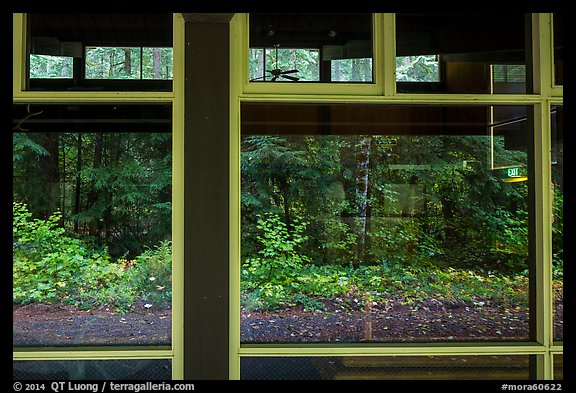
The Ohanapecosh area harbors some of the largest old-growth trees in the park. A 1.5-mile RT trail leads to the Grove of the Patriarchs, situated on an island on the Ohanapecosh River, accessed through a fun suspension bridge. The grove features some seriously impressive big trees, whose size reminded me of the California redwoods.
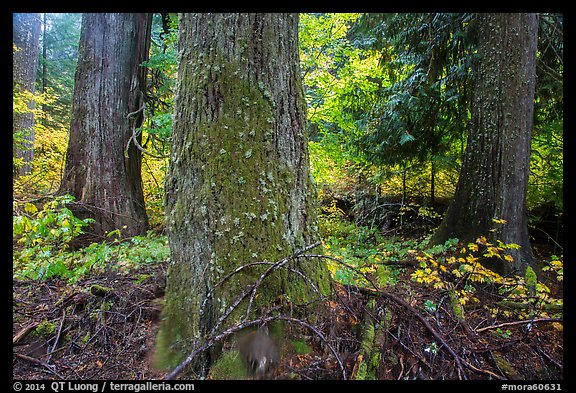
Although the grove is small, and spent hours there to find compositions that would hide the boardwalk. The soft light was great and rain brought out colors in the old-growth forests.

Although I found good autumn color in the grove, the most colorful spot was on the shores of the Ohanapecosh River from the north end of the island.

On the way back, I noticed those Maple trees leaves and branches lining up Ohanapecosh River along the trail, that I had missed in my haste to get to the Grove of the Patriarchs. Remember that the journey is as important as the destination and keep looking!

Driving west, I noticed a colorful carpet of ferns before Steven Creek Canyon. The TSE-24mm served double-duty of keeping the foreground ferns – which were less than a foot from the lens – sharp with tilt and the background trees parallel with shift.

Stevens Canyon was the only place in the park where I found autumn foliage on distant hillsides – as opposed to within a forest. Although it was raining steadily, since the wind was blowing from my back, keeping the camera and lens dry were not a problem.

A short distance up the road from the trailhead to Comet Falls, Van Trump Creeks drops 40 feet at Christine Falls. Its proximity makes it a great subject for a rainy day, but you can easily miss it because it is under the road bridge just below. A stroll starting from the southeast side of the bridge leads to a viewpoint from which you can frame the waterfall with the bridge. I tried compositions with and without the bridge, but liked the ones with the bridge better because they were more specific.
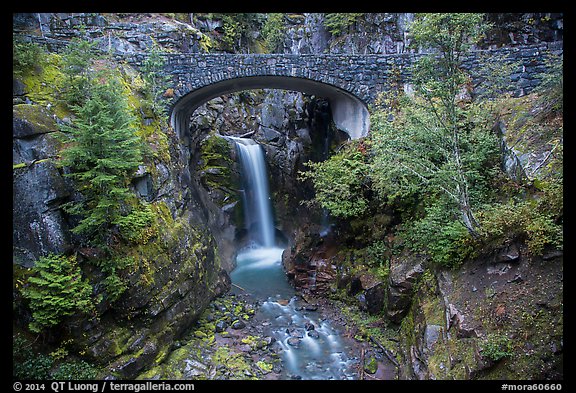
Less than a mile from the junction with the Paradise road, a large parking lot gives access to Narada Falls. It is normally a popular attraction, but on that day the lot was empty. On the way to the falls, you pass its feeding stream. During my previous visit there, I did not even stop. However, on that rainy day which made the trees recede in the distance, I found it just as fascinating the the falls itself.

A short but steep trail (0.4 miles RT, 200 feet elevation) leads you down for close views of the waterfall dropping in a steep amphitheater. Although the light was similar to when I photographed Narada Falls a decade and half ago, I returned to see if I’d photograph it differently than a decade and half ago. I did. Do you find your compositions change over time ?
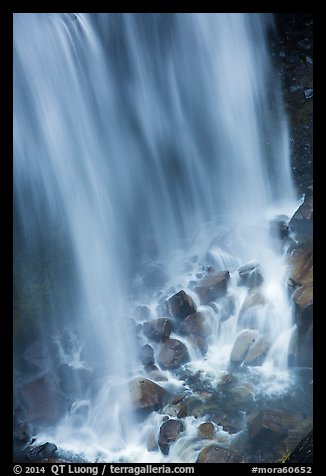
More images of Mount Rainier National Park

